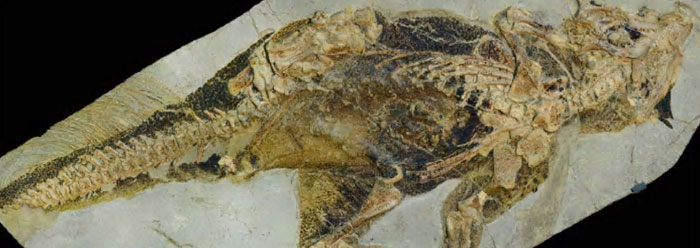2016 revealed Cretaceous bird-feather proteins, original dinosaur-skin tissue, Triassic mosasaur blood vessels, and organic remnants from ancient fossil microbes. These four finds challenge scientists to question the popular model.
The first find: Researchers studied a dark-winged Cretaceous bird fossil from China that revealed not just the feather-protein keratin, but also keratin associated with melanosomes—the tiny structures that darken feathers. Finding both of these feather elements together refutes the speculative explanation that the melansomes might be modern bacteria, since modern bird-feather melanosomes also come embedded in keratin, and bacteria do not.1
Both keratin and melanosomes have expected shelf lives far shorter than this fossil's evolutionary age assignment of about 130 million years. How could these materials have lasted even one percent (1.3 million years) of that supposed time span? Plus the second find, the 2016 description of dinosaur skin melanosomes with signs of actual collagen increases this question's tension.2
The third find: Collagen protein remnants were found in mosasaur blood vessels in Poland.3 The scientists who described the find suggested that a blood-bath chemistry preservation story somehow explains these supposedly long-lasting proteins. The story relates how iron may have leaked out of a dead animal's blood, coated the inside and outside of nearby blood vessels, and then the iron encouraged cross-linking reactions. Finally, cross-linked proteins might have solidified enough to last tens of millions of years.4 Scientists noticed an extremely thin coating of iron-containing mineral over the mosasaur blood vessels. That seemed to fit the blood preservation story, but only by ignoring other important details.
To begin, nobody knows what could have extracted the iron from the mosasaur blood, where to find enough iron, or how to spread it around without using water. And water accelerates tissue decay—the very feature this blood story is supposed to explain away. Even granting solutions to these problems, iron actually helps destroy proteins much more often than it might help cross-link them. But the Polish team's description of short-lived amino acids within mosasaur collagen showed that the cross-linking never really happened anyway.5 While it's possible the mineral coating kept microbes at bay for thousands of years, it certainly didn't slow the inevitable chemistry of decay. And that leaves no trustworthy tale to rescue these fossils from their over-the-top age assignments.
The fourth find: The 2016 grand prize for challenging evolutionary time with organic material in fossils may well belong to protein remnants discovered in "1.88 billion-year-old" rocks. Ontario's Gunflint chert contains microfossils—fresh-looking "fossil" remains of single-celled algae caught in ancient mud. Using a sophisticated microprobe, researchers verified algal remains similar to the amino acid signatures from the Polish marine reptile fossils in our third find. No scientific study even hints that amino acids could resist chemical reactions for a measly million years, let alone almost two billion.
Long before these discoveries, Bible-believing scientists described Earth's rock systems as Noah's Flood deposits from thousands of years ago, not millions.6 According to Scripture, this Flood happened thousands of years ago, not billions. Short-lived proteins and tissues from the bottom to the top rock layers fit the framework of Noah's Flood and make 2016 a great year to compare fossil discoveries to Genesis history.
References
- Clarey, T. Fossil Feather Proteins Confirm Recent Flood. Creation Science Update. Posted on ICR.org December 12, 2016, accessed December 6, 2016.
- Thomas, B. Scales, Colors, Proteins in Dinosaur Skin. Creation Science Update. Posted on ICR.org September 29, 2016, accessed November 29, 2016.
- Thomas, B. Organic Residue Is 247 Million Years Old? Creation Science Update. Posted on ICR.org May 9, 2016, accessed November 29, 2016.
- Thomas, B. Dinosaur Soft Tissue Preserved by Blood? Creation Science Update. Posted on ICR.org December 11, 2013, accessed December 1, 2016.
- The same chemistry that produces protein cross-linking would have first degraded the still-reactive amino acids found in the blood vessel tissues.
- Morris, H., and J. Whitcomb. 1961. The Genesis Flood. New Jersey: Presbyterian and Reformed Publishing Co.
Image credit: Copyright © 2016 J. Vinther. Cell Press. Adapted for use in accordance with federal copyright (fair use doctrine) law. Usage by ICR does not imply endorsement of copyright holders.
*Mr. Thomas is Science Writer at the Institute for Creation Research.
Article posted on December 19, 2016.

























